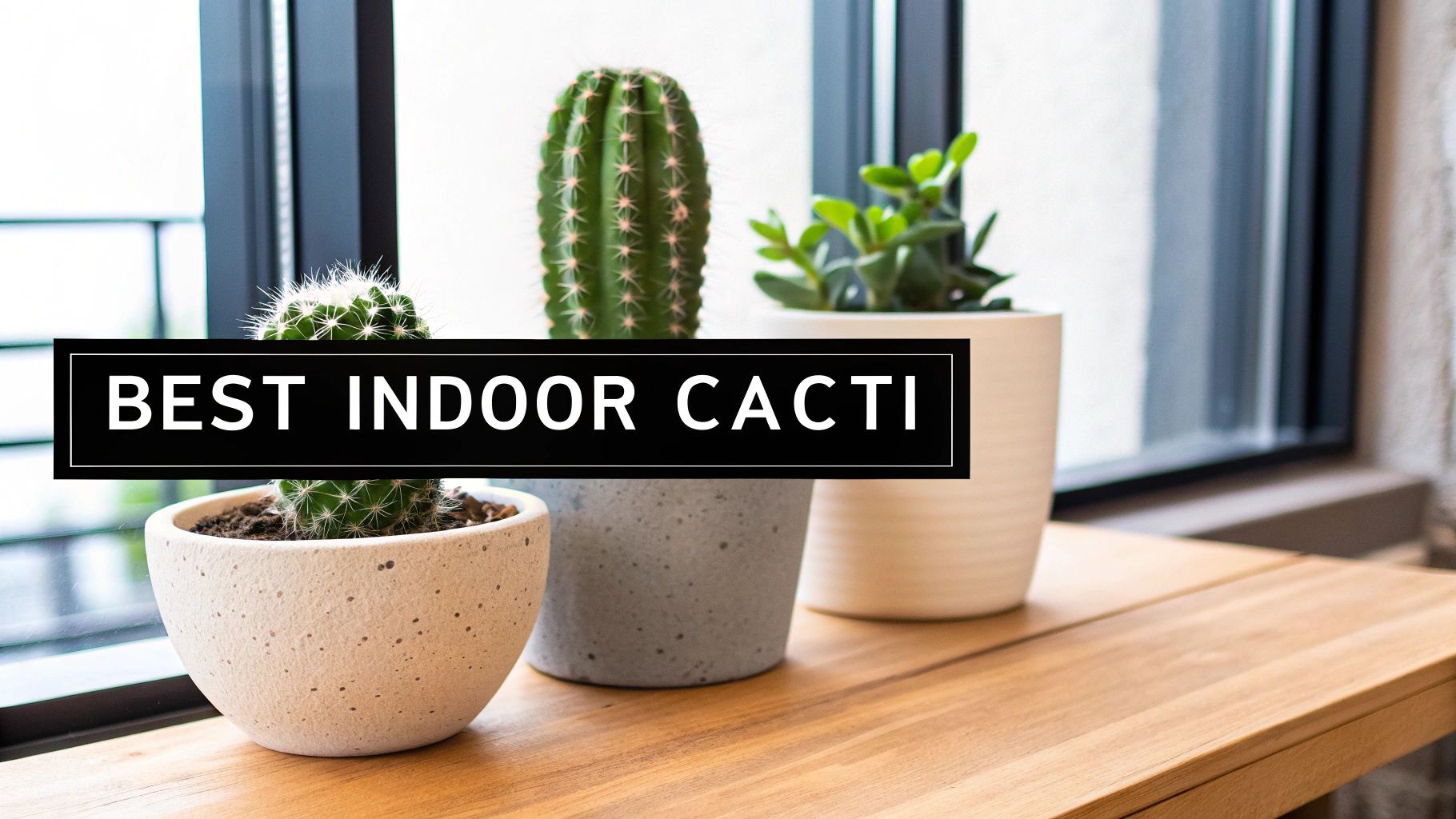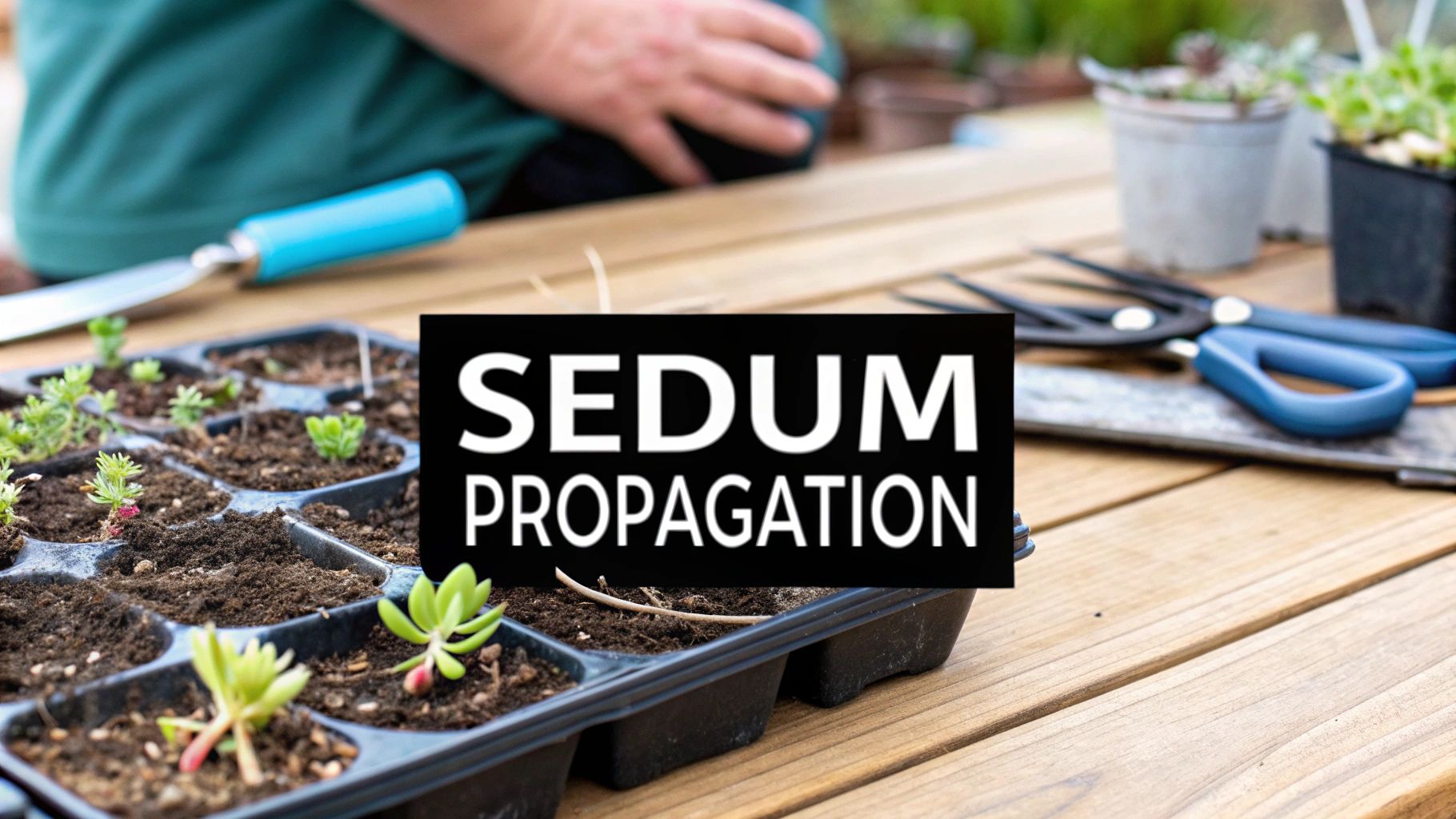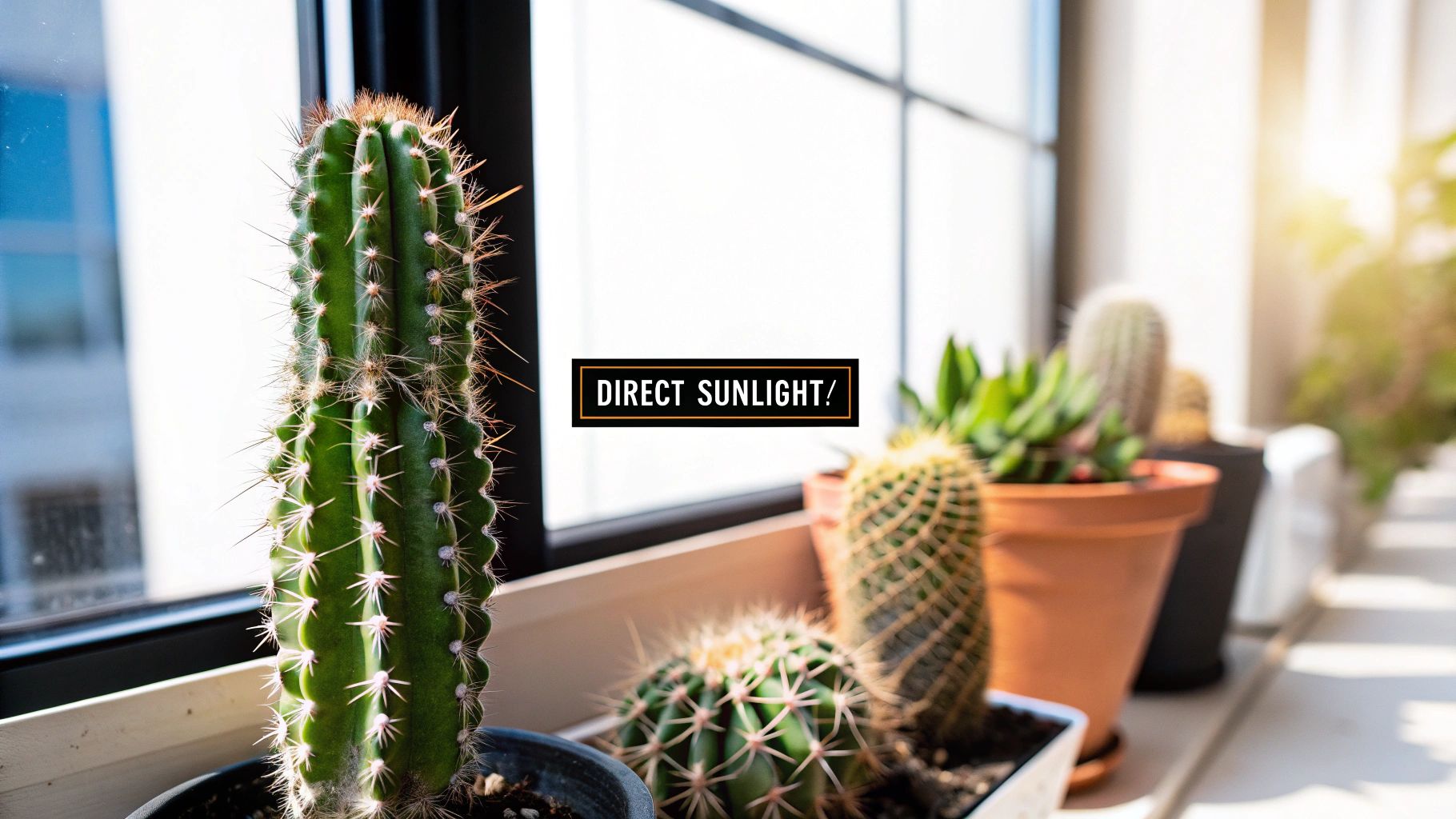The best indoor cactus isn't just about looks; it's about finding one that fits your home's light conditions. A low-light tolerant Snake Plant might thrive where a sun-hungry Bunny Ears Cactus would falter. Your success truly begins the moment you choose a variety that will be happy in your specific environment, not just one that catches your eye at the nursery.
Getting this choice right from the very beginning is the most important thing you can do.
Choosing a Cactus That Fits Your Home
Before you bring home a new spiky friend, you need to play matchmaker between the plant and your living space. So many people make the mistake of buying a cactus on impulse, only to watch it slowly struggle because their home just isn't the right fit. The good news? A quick assessment of your rooms can set you and your new plant up for a long and happy life together.
The most critical factor, by a long shot, is light. Cacti have this reputation for needing scorching desert sun, but a surprising number of popular indoor varieties actually prefer bright, indirect light. It helps to think of your home as having different light "zones."
Understanding Your Home's Light Zones
A south-facing window is prime real estate for sun-loving cacti. It provides the most intense, direct light for the longest part of the day, making it the perfect spot for species that can't get enough brightness.
On the other hand, east-facing windows offer gentle morning sun. This is ideal for many cacti that might get scorched by harsh afternoon rays. West-facing windows get that intense afternoon sun, which can be great for some but might stress out others. And a north-facing window? That spot gets the lowest light and is really only suitable for the most tolerant species, like a Snake Plant or Christmas Cactus.
For a deeper dive, our article on https://www.cactusoutlet.com/blogs/blog/where-is-the-best-place-to-put-a-cactus-in-the-house offers some fantastic insights on placement.
Take a day to just watch how the light moves through your home. Pay attention to which windows get hit with direct sunbeams and for how many hours. This simple audit will tell you exactly where a high-light or medium-light cactus will truly thrive.
Beyond Just Sunlight
While light is the headliner, temperature and humidity play crucial supporting roles. Most cacti are perfectly happy in the same temperatures we are—somewhere between 65-80°F (18-27°C). This makes them fantastic houseplants, but they are sensitive to drafts. Be sure to keep them away from drafty windows, air vents, or doors that open and close all the time.
Humidity is another big piece of the puzzle. Cacti come from arid places and, as a rule, they really dislike damp, humid air. Too much moisture in the air can lead to fungal diseases and dreaded root rot.
When picking your plant, think about your home's natural climate. While cacti love dry air, knowing how to manage your home's humidity levels can create a better environment for all your plants. A bathroom that gets steamy from the shower, for instance, is a terrible spot for almost any desert cactus.
Alright, you've assessed your space, and now for the best part—picking out your new cactus. The world of cacti is huge, stretching far beyond the classic Saguaro silhouette you see in movies. Finding the right one is about matching a plant's personality and needs with what your home can offer.
Let's dive into some fantastic options that will add a unique touch to your indoor garden.
The Holiday Bloomers
When you picture a flowering houseplant, a cactus probably isn't the first thing that springs to mind. But some of the most beloved indoor cacti are famous for their absolutely stunning seasonal flowers, giving you a pop of color when you least expect it—right in the middle of winter.
A perfect example is the **Christmas Cactus (Schlumbergera spp.)**. This isn't your typical desert dweller. It actually comes from the coastal mountains of Brazil, so it prefers to skip the harsh, direct sun. Its unique, segmented stems cascade beautifully over the side of a pot, and right around the holidays, they erupt in brilliant pink, red, or white flowers.
The Christmas Cactus has become a true phenomenon. In the United States, its popularity has skyrocketed, with its presence in nurseries growing by over 150% between 2000 and 2023. It’s a testament to our growing love for easy-care plants that offer something special. You can learn more about its fascinating history and care requirements from the experts at Cactus Vision.

While cacti aren't the heavyweight champions of air purification, they absolutely contribute to a more calming and natural vibe in your home.
Cacti With Unique Textures
Forget the idea that all cacti are sharp and prickly. Plenty of varieties have soft spines or fascinating textures that are surprisingly touchable. These are great choices if you have curious kids or pets, or if you just prefer a softer aesthetic.
One of my personal favorites is the Feather Cactus (Mammillaria plumosa). This little guy grows in clusters and is covered in soft, white, feather-like spines that completely hide its green body. The result is a fluffy, almost snowball-like appearance that's totally unique. It’s happiest with bright, indirect light and very little water, especially when it goes dormant in the winter.
Another wonderful choice is the Old Lady Cactus (Mammillaria hahniana). It forms a perfect sphere covered in fine white hairs and spines, giving it a cozy, woolly look. With a little patience, it will reward you with a "crown" of gorgeous pinkish-purple flowers in the spring.
Don't let their soft look fool you! While the spines are less threatening, the care fundamentals are the same. They still need excellent drainage, precise watering, and the right amount of light to avoid the dreaded root rot, just like their spikier relatives.
Architectural and Statement Cacti
If you're after a plant that doubles as a piece of living art, you're in luck. Many cacti have strong, architectural forms that can become a focal point in any room.
- **Fairy Castle Cactus (Acanthocereus tetragonus 'Fairy Castle')**: The name says it all. This cactus grows a cluster of stems at different heights, creating a silhouette that looks just like a tiny fairytale castle. It's a slow grower, so it won’t outgrow its spot too quickly.
- Moon Cactus (Gymnocalycium mihanovichii): You’ve probably seen these colorful characters. The Moon Cactus is actually two different cacti grafted into one. The vibrant red, yellow, or pink top can't make its own food, so it relies on the green rootstock cactus to live.
- Bunny Ears Cactus (Opuntia microdasys): An absolute classic for a reason. This cactus grows in paired pads that look just like rabbit ears. It’s covered in tiny, hair-like prickles called glochids (so handle with care!), but its charming shape makes it a perennial favorite.
Comparing the Best Indoor Cactus Plants
To make your decision a little easier, here's a quick side-by-side look at some of the top contenders for your indoor space. Each one brings something a little different to the table.
| Cactus Name | Light Needs | Watering Frequency | Unique Feature |
|---|---|---|---|
| Christmas Cactus | Bright, indirect light | Every 1-2 weeks (more when blooming) | Cascading stems, vibrant holiday blooms |
| Feather Cactus | Bright, indirect light | Every 3-4 weeks (very little in winter) | Soft, feather-like white spines |
| Old Lady Cactus | Full sun to bright, indirect | Every 2-3 weeks | Woolly appearance, pink flower crown |
| Fairy Castle Cactus | Full sun to bright, indirect | Every 2-4 weeks | Grows in a cluster resembling a castle |
| Bunny Ears Cactus | Full sun | Every 3-4 weeks | Grows in paired pads that look like ears |
Ultimately, choosing the right cactus is a personal decision. By understanding what makes each species tick, you can pick a plant that won't just survive in your home—it will thrive and become a feature you’ll love for years to come.
How to Pot Your Cactus for Long-Term Health
Giving your new cactus the right home from the very beginning is one of the most critical things you can do for its health. A lot of new owners make the classic—and often fatal—mistake of using standard potting soil. That stuff holds way too much water and is a fast track to root rot, which is the number one killer of indoor cacti.
The whole goal here is to mimic the dry, gritty environment your cactus came from.
This process starts with the pot itself. I know those beautiful decorative pots without drainage holes are tempting, but for a cactus, they're a death trap. Excellent drainage is non-negotiable. Seriously. Always, always choose a pot with at least one good-sized drainage hole at the bottom. This is the only way for excess water to escape and prevent the soil from turning into a swamp.

Choosing the Right Pot Size and Material
When it comes to picking a pot size, bigger is definitely not better. It’s a common misconception. A pot that's too large holds a ton of extra soil, which then holds excess moisture that the cactus's small root system simply can't absorb.
A good rule of thumb is to select a pot that is only about 1-2 inches wider in diameter than the cactus itself. This gives the roots just enough room to grow without leaving them swimming in wet soil.
The pot's material makes a big difference, too.
- Terracotta or clay pots are my top recommendation. They are porous, meaning water can evaporate right through the sides of the pot. This helps the soil dry out much faster and more evenly.
- Glazed ceramic or plastic pots don't "breathe" at all, so they hold onto moisture for a lot longer. If you fall in love with one of these, you just have to be extra careful not to overwater.
A typical scenario I see all the time is someone bringing a new cactus home in its flimsy plastic nursery pot. The best thing you can do is repot it into a proper terracotta container with fresh, appropriate soil within a few weeks. It makes all the difference.
Creating the Perfect Cactus Soil Mix
You absolutely cannot use all-purpose potting soil straight from the bag. It’s just too dense and heavy. Cacti need a gritty, chunky, fast-draining soil that won’t get compacted. You've got two solid options: buy a pre-made mix or make your own.
You can find commercial cactus and succulent soils pretty easily, and they're a decent starting point. To really nail it, though, I even recommend amending these pre-made mixes to improve drainage further.
If you want to create your own (it's easy!), here is a fantastic, foolproof recipe for a blend that provides incredible drainage:
- 2 parts standard potting soil
- 1 part perlite (adds lightness and aeration)
- 1 part coarse sand or pumice (for grit and drainage)
This mix has just enough organic material to provide nutrients but allows water to drain through quickly, which is exactly what keeps the roots healthy and happy.
Getting this foundation right is everything. For a more detailed walkthrough of the actual potting process, this guide on how to repot cacti is an excellent resource. Nailing this step is the key to enjoying your indoor cactus for years to come.
Mastering Cactus Watering and Feeding
When it comes to cacti, people often think "low-maintenance" means "no-maintenance." While they are tough, the single biggest mistake I see enthusiasts make is killing their plants with kindness—specifically, with too much water. The real secret isn't neglect; it's about understanding how to water them in a way that mimics their life in the desert. This means tossing out your rigid weekly watering schedule and learning to listen to your plant.
Overwatering is, without a doubt, the number one killer of indoor cacti. Their root systems just aren't built to sit around in soggy soil, and it’s a fast track to root rot, which is almost always a point of no return. The best approach I've found over the years is the "soak and dry" method. It’s the gold standard for a reason.
The Soak and Dry Watering Method
The technique itself is beautifully simple. When you water, you water deeply. Let the water drench the soil completely, until you see it pouring out of the drainage hole at the bottom of the pot. This ensures that every single root gets access to moisture.
And then comes the most important part: you wait. You let that soil dry out 100%. I don't mean just the top inch—I mean all the way through, from top to bottom. How long does that take? It completely depends on your home's conditions. It could be two weeks, four weeks, or even longer during the darker winter months.
So how do you know when it's truly dry? Here are a few reliable tricks I use:
- The Finger Test: Don't be shy. Stick your finger as deep into the soil as you can. If you feel even a hint of coolness or moisture, it's not time yet.
- The Chopstick Method: A simple wooden skewer or a disposable chopstick works wonders. Push it down to the bottom of the pot. If it comes out with any damp soil clinging to it, give it more time.
- The Lift Test: Get a feel for how heavy your potted cactus is right after you've watered it. A pot full of bone-dry soil is surprisingly lightweight in comparison.
The most critical piece of advice I can give you is this: When in doubt, don't water. A thirsty cactus will bounce back just fine. A waterlogged one suffering from fungal rot probably won't.
If you want to get really granular on this, we've put together a more in-depth resource on how often you should water a cactus that covers different scenarios.
Feeding Your Cactus for Healthy Growth
Just like with watering, a light touch is key when it comes to fertilizer. Cacti are slow-growers and don't need a lot of food, but giving them a little nudge during their growing season can make a real difference, encouraging more robust growth and sometimes even beautiful blooms.
Timing is everything. Cacti are actively growing in the spring and summer, and that’s the only window you should be feeding them. Fertilizing a dormant plant in fall or winter is a big no-no; the roots can't use the nutrients, which can lead to chemical burn.
Look for a balanced, water-soluble fertilizer made for cacti or succulents, which will have the lower nitrogen levels they prefer. Here's the key: dilute it to half or even quarter strength of what the package instructions say. Think of it as a very weak nutrient tea.
Apply this diluted mix about once every 4-6 weeks during the spring and summer, using it in place of a regular watering. That's it. This simple routine is more than enough to give your cactus the fuel it needs to thrive without overloading its sensitive system.
What to Do When Your Indoor Cactus Looks Sick
Even with the best care, sometimes an indoor cactus just looks... off. Don't panic. Think of it as your plant’s way of talking to you. When you learn to spot these little warning signs early, you can usually fix whatever is wrong before it becomes a major problem.
Most issues, from a sudden color change to unwelcome little critters, come down to a handful of common culprits. The trick is to figure out the root cause instead of just reacting to what you see on the surface.

Reading Changes in Color and Feel
It’s always a little jarring to see your cactus changing color or getting soft. If the base of your cactus is mushy, brown, or black, you’re almost certainly looking at root rot. This is the number one killer of indoor cacti, and it’s almost always caused by too much water.
If you catch it early, you might be able to perform some plant surgery. Take it out of the pot, use a clean knife to cut away all the rotten, mushy parts, let the healthy part dry and form a callous for a few days, and then repot it in fresh, completely dry cactus soil.
Yellowing stems are a bit trickier. It could still be an overwatering issue, but it can also signal that the plant is hungry for nutrients. If it's been over a year since you last fertilized, a little bit of diluted cactus food during its spring or summer growing season might be all it needs.
A classic mistake I see all the time is putting a cactus in a beautiful decorative pot that has no drainage holes. Water gets trapped in the bottom, creating a swampy mess that rots the roots, even if you feel like you're barely watering. Always, always choose drainage over looks.
Fixing Weird Growth Habits
Is your cactus looking tall, skinny, and a bit pale, like it's stretching for the ceiling? That’s a textbook case of etiolation. It’s the plant’s desperate attempt to find more light. The stretched-out part will never go back to its original compact shape, but if you move it to a sunnier spot, any new growth will be much healthier and tighter.
On the other hand, have you noticed scorched-looking white or yellow patches on the side of your cactus facing the sun? That’s a plant sunburn. It happens when a cactus is suddenly moved from a low-light area into intense, direct sun without any time to adjust. The key is to acclimate it slowly. Just move it into the brighter light for a little longer each day over the course of a week or two.
Dealing With Common Pests
Yep, even indoor plants get pests. They’re usually tiny and hard to see until you’ve got a real infestation on your hands.
- Mealybugs: These look like tiny pieces of white, fuzzy cotton. You'll find them tucked into the crevices where stems join or hidden at the base of the spines.
- Spider Mites: You’ll probably notice their super-fine webbing before you spot the mites themselves. They love dry air and will make the cactus skin look stippled or bronzed.
For both of these, the first line of attack is simple. Dip a cotton swab in 70% isopropyl alcohol and dab it directly on the pests. It kills them instantly without hurting the cactus. If you have a bigger problem, a good spray-down with insecticidal soap is the next step.
Some cacti are pest magnets. The Feather Cactus (Mammillaria plumosa), for example, has incredibly dense, soft spines that are perfect hiding places. It's a hugely popular indoor choice—its availability in nurseries has jumped by nearly 45% since 2015—but you have to be vigilant. For plants like this, a preventative spray with a neem oil solution every few weeks can keep pests from ever getting a foothold. If you're curious about this variety or others, The Next Gardener has some great info on popular home-friendly cacti.
Your Indoor Cactus Questions Answered
It's one thing to read a guide, but it's another to have a plant in your hands and suddenly have a million questions. Let's tackle some of the most common head-scratchers people run into when they start growing these amazing plants indoors.
Can Any Cactus Live Indoors?
I wish I could say yes, but the reality is that not every cactus is cut out for life inside. Think about those iconic Saguaro cacti you see in Westerns—those giants are built for the intense, unfiltered desert sun. Trying to grow one in your living room is a recipe for a sad, stretched-out plant. It just won't work.
The real trick is to pick the right plant for the job. Smaller, slower-growing desert species are often your best bet. On the other hand, you have the "jungle cacti" like the familiar Christmas Cactus. These guys are fantastic indoor options because they evolved to live under forest canopies, so the filtered light in our homes feels just right to them.
Here’s the golden rule: Success is all about matching the cactus to the light you actually have. Don't fall in love with a sun-worshipper if all you can offer is a dim corner.
How Often Should I Repot My Indoor Cactus?
This is a question that seems to cause a lot of stress, but the answer is surprisingly low-maintenance: not very often at all. Cacti are slow-pokes when it comes to growth, and they actually prefer being a little bit crowded in their pots. Being slightly root-bound helps the soil dry out faster, which is exactly what they want.
As a general guideline, you'll probably only need to repot every 2-4 years. The most obvious sign that it's time for a new home is when you start seeing roots peeking out of the drainage hole.
When that day comes, don't go crazy with a huge new pot. The goal is a modest upgrade. Choose a pot that's only 1-2 inches wider than the current one. This prevents having a huge mass of extra soil that just sits there, holding moisture and creating a perfect storm for root rot.
Why Is My Cactus Turning Brown at the Base?
Seeing your cactus turn brown at the bottom can be alarming, but you need to play detective before you panic. It usually points to one of two very different things.
First, give it a gentle poke. If the brown spot is soft, mushy, or feels hollow, you're almost certainly dealing with root rot from too much water. This is an emergency room situation for your plant. You need to pull it out of the pot immediately, use a clean knife to cut away every last bit of rotted tissue, and let the healthy part callus over before repotting it in fresh, bone-dry cactus mix.
However, if the base is firm, dry, and has a woody texture, what you're seeing is probably corking. This is a perfectly natural aging process where the cactus strengthens its base to support its own weight as it gets taller. Corking is just a sign of maturity, not a cause for concern.
Ready to find the perfect prickly friend for your space? At The Cactus Outlet, we have a massive selection of healthy, happy cacti and succulents that we ship right to your doorstep. Come explore the collection and get your indoor desert garden started.




